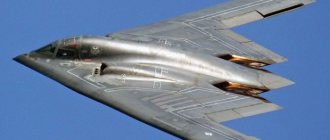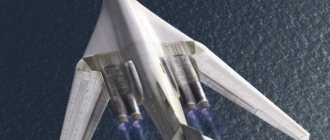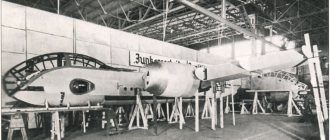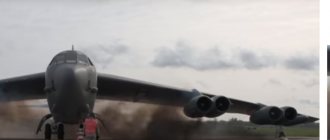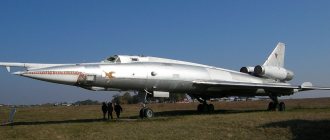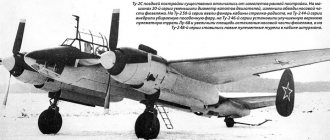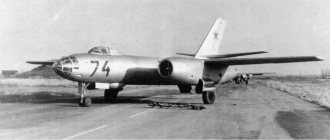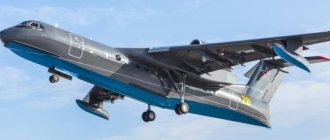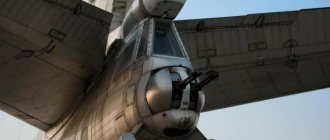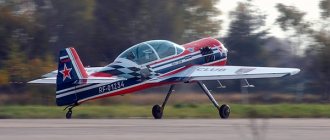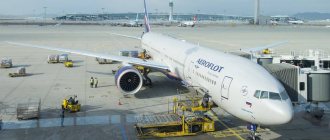Combat use
The wreckage of a B-29 shot down on November 9, 1950 by Soviet MiG-15s
was not used in bombing raids in the Western European theater of operations, used only in the Pacific theater of operations, since 1944.
Korean War
According to American researcher Joe Bauer, 16 B-29s were lost to enemy fighters. At the same time, according to official American data (USAF Statistical Digest document FY1953), the US Air Force lost 17 B-29s from fighter fire, another 5 were shot down by fire from the ground, 2 were shot down by unknown means, 27 were lost in battle for non-combat reasons (collision with the ground , fuel consumption, critical malfunctions), 6 were missing, 12 were lost for “other non-combat reasons” and 9 crashed in disasters. The RB-29 reconnaissance aircraft also suffered losses: 1 "other combat loss", 2 missing in action, 1 lost to "other non-combat causes" and 3 crashed in crashes. SB-29 aircraft also took part in the war, and at least 1 such aircraft is known to have been lost. This gives no less than 86 irretrievable losses of B-29 aircraft during the war.
According to Soviet data, 69 B-29s were shot down by Soviet MiG-15 fighters, not counting those shot down by Chinese fighters.
Neutral Western researchers who studied the use of the B-29 indicate that the losses of bombers from the fire of Soviet MiGs amounted to 44 aircraft, another 4-5 were shot down by Chinese and Korean fighters. The most B-29 losses were on April 12, 1951, when 12 bombers were shot down or written off by Soviet MiG-15 fire in one day.
Known B-29s
- Enola Gay
(serial number 44-86292) - the plane that dropped the atomic bomb on Hiroshima. Located at the National Air and Space Museum. - Bockscar
(serial number 44-27297) - the plane that dropped the atomic bomb on Nagasaki. Located at the National Museum of the United States Air Force. - Command Decision
(serial number 44-87657) is an aircraft whose gunners scored five aerial victories over MiG-15 fighters during the Korean War. - (serial number 44-62070) - the last airworthy B-29. From 2006 to 2010, it did not take to the skies due to problems with the engines (their “repairs” were carried out by simply replacing them with those available in warehouses, but these stocks came to an end). Since August 2010 it has been in the sky again, after installing new (not “original”) engines.
operators
United States US Air Force
| B-50 Superfortress 2d Bombardment Wing, 1949-1953 43d Bombardment Wing, 1948-1954 93d Bombardment Wing, 1949-1954 Bombardment 97th Wing, 1950-1955 Bombardment 306th Wing, 1951 Bombardment of the Kry LA 509th, 1949-1954 RB-50 Superfortress 55th Strategic Reconnaissance Wing, 1950-1954 91st Strategic Reconnaissance Wing, 1949-1950 (B-50); 1950-1951 WB-50 Superfortress 53d Weather Reconnaissance Squadron, 1955-1965 54th Weather Reconnaissance Squadron, 1955-1960; 1962-1965 Fifty-fifth Weather Reconnaissance Squadron, 1958-1960 (TB-50); 1960-1963 Weather 56th Reconnaissance Squadron, 1956-1962 Weather 57th Reconnaissance Squadron, 1956-1958 Weather 58th Reconnaissance Squadron, 1956-1958 Weather 59th Reconnaissance Squadron, 1955-1960 | KB-50 Superfortress Refueling 421st Air Squadron 47th Bombardment Wing, tactical, 1955-1964 (USAFE) Refueling 421st Squadron 49th Fighter-Bomber Group, 1955-1957 67th Tactical Reconnaissance Wing, 1957-1960 3d Tactical Bombing Wing (Attached), November 1960 – June 1962 (PACAF) 427th Air Refueling Squadron 4505th Refueling Wing, 1959-1963 Refueling Squadron 429th Air Refueling Wing 4505th, 1958-1963 431st Air Refueling Squadron 4505th Refueling Wing , 1958-1963 4440th Aircraft Group Delivery, 1963-1965 622d refueling Squadron 4505th refueling Wing, 1957-1963 |
Options
XB-44 One B-29A was transferred to Pratt & Whitney for use as a test bed for the installation of new 28-cylinder main engines in the B-29. The B-29D Wasp Major operates a bomber, with a strong structure and a taller tail. Redesignated B-50A in December 1945. B-50A First production version of the B-50. Four R-4360-35 Wasp Main engines, 168,500 lb (76,400 kg) Max takeoff weight. A total of 79 were built. TB-50A
– Conversion of 11 B-50As as crew trainers for units operating on the B-36. B-50B Improved version, with increased maximum take-off weight of 170,400 lb (77,300 kg) and new, lighter fuel tanks. 45 built.
EB-50B with Track Tread-Running
EB-50B
– Single The B-50B is modified as a test bed for a bicycle chassis and then used to test the "track" of the chassis.
RB-50B
– Conversion of the B-50B for strategic reconnaissance, with a capsule in the rear fuselage carrying nine cameras in four stations, meteorological instruments and additional crew.
Can be equipped with two 700 US-gallon (2,650 L) tanks under the outer wings. 44 converted from B-50B. YB-50C A prototype of the B-54 bomber to have a variable exhaust turbine (i.e. turbo-link) version of the R-4360 engine, a longer fuselage and larger, stronger wings. One prototype started but was canceled before completion. B-50D The final version of the B-50 bomber. Higher maximum takeoff weight (173,000 lb (78,000 kg)). Equipped with a vessel for refueling in flight and provide an underwing PTB. Modified nose glazing with a 7 piece nose cone window was replaced by a single plastic cone and Aimer's flat bomb window. A total of 222 were built. DB-50D
– One B-50D is being converted as a director-unmanned conversion of the B-50D, for testing with the GAM-63 Rascal missile.
KB-50D
– conversion of a prototype of two B-50DS into a three-point aerial refueling tanker using stabilizing type hoses.
Used as a basis for subsequent production of KB-50J and KB-50K conversions. A further conversion from the TB-50D, the KB-50D was also designated. TB-50D
– Conversion of the early B-50DS lacking antenna-refueling receptacles as unarmed team trainers.
Eleven were converted. WB-50D
– Conversion of the surplus B-50DS as a weather reconnaissance aircraft to replace worn-out WB-29s. Equipped with Doppler radar, atmospheric sampler and other special equipment, as well as additional fuel in the bomb bay. Some of them were used on a highly classified atmospheric sampling mission from 1953 to 1955 to detect Soviet detonation of atomic weapons. RB-50E 14 RB-50Bs converted to Wichita for photographic reconnaissance specialists. RB-50F Conversion of 14 RB-50Bs as a survey aircraft equipped with radio navigation radar. RB-50G Conversion of the RB-50B for electronic reconnaissance. Equipped with radio navigation for navigation, and six electronic stations, with a crew of 16 people; 15 converted. TB-50H Unarmed aircrew trainer for B-47 squadrons. 24 completed, last B-50s built. All later converted to KB-50K tankers. KB-50J Conversions to air-to-air tankers with improved performance from two additional General Electric J47 turbojets under the outer wings, 112 converted from B-50D, TB-50D, RB-50E, RB-50F and RB-50G aircraft. The KB-50 136 is a three-point hose conversion of Hayes Industries stabilizing tankers, with auxiliary outboard fuel tanks and hose pods under the wing tips. KB-50K Tanker conversion level of TB-50H trainer aircraft. 24 converted. B-54A Proposed variant of the YB-50C. RB-54A Proposed reconnaissance variant of the YB-50C. The WB-50 Weather reconnaissance aircraft is converted from the B-50A aircraft.
World War I
At the very beginning, airplanes carried out bombing purely to intimidate the enemy. Light reconnaissance aircraft were used as carriers. Bombs were dropped manually by pilots, and operations were not coordinated with those of ground troops. The first bombing of Paris took place at the end of August 1914. In November of the same year, Lieutenant Caspar bombed Dover.
But airships showed themselves best during this period. Germany was the most powerful aeronautical power. With 18 copies, it could drop several tons of bombs. In mid-August 14, one of the airships carried out an air raid on Antwerp, destroying 60 residential buildings, more than 900 were damaged. But the British anti-aircraft gunners managed to shoot down 4 units, after which the Germans refused to operate the airships during the daytime.
The first full-fledged bomber that fully corresponds to the rank of bomber was the Russian four-engine vehicle Igor Sikorsky “Ilya Muromets”. In December 1914, the “Squadron of Airships” was created from these “Murom residents”. Bombs were placed not only inside the plane, but also outside. In addition, the installed machine guns were responsible for protecting the aircraft. The first multi-engine bombers began to appear in many countries. One way or another, they looked like “Ilya Muromets”. Germany – G-III, G-IV, GV, “Zeppelin-Staken R-VI”; England – 0/400, Vickers Vimy; USA - Martin MV-1.
Technical data
Boeing B-29 Superfortress
The given characteristics correspond to the B-29
.
Data source: Standard Aircraft Characteristics;
Loftin LK, Jr., 1985. Specifications
- Crew: 11 (pilot, co-pilot, flight engineer, navigator, radio operator, radar operator, navigator-bombardier, 4 gunners)
- Length: 30.18 m
- Wingspan: 43.04 m
- Height: 8.47 m
- Wing area: 159.79 m²
- Leading edge sweep
: 7° 1′ 26 - Wing aspect ratio
: 11,5 - Average aerodynamic chord:
3.92 m - Wing profile: Boeing 117
- Chassis track
: 8.69 m - Empty weight: 32,432 kg
- Curb weight: 36,652 kg
- Maximum take-off weight: 63,503 kg
- Maximum landing weight:
61,235 kg - Weight in combat:
45,926 kg - Fuel mass in internal tanks: 25,482 kg (with tanks in bomb bays)
- Fuel tank capacity
: 35,443 l (with tanks in bomb bays) - Powerplant: 4 × air-cooled Wright R-3350-79
- Engine power: 4 × 2200 l. With. (4 × 1640 kW)
- Propeller: four-blade variable pitch Hamilton Std 6526A-6
- Screw diameter: 5.05 m
- Drag coefficient at zero lift:
0,0241 - Equivalent resistance area:
3.82 m²
Flight characteristics
- Maximum speed: 604 km/h (at an altitude of 9144 m)
- Cruising speed: 547 km/h
- Stall speed: 191 km/h (at maximum take-off weight)
- Combat radius: 3413 km
- Practical range: 6380 km
- Ferry range: 8321 km (with maximum fuel, without bombs)
- Service ceiling: 12,070 m (at combat weight)
- Rate of climb: 8.26 m/s
- Climb time:
3048 m in 23.5 minutes - 6096 m in 61.5 m
16,8
Armament
- Small arms and cannon: 12 × 12.7 mm machine guns with 500 rounds. each 4 on top of the fuselage at the front
- 2 on top of the fuselage at the rear
- 2 under the fuselage at the front
- 2 under the fuselage at the rear
- 2 in the stern
- normal:
4536 kg
9072 kg
- 40 × 227 kg
TOP best bombers of all time
Military aviation brings death from the skies. Unexpected and inevitable. “Sky Slugs” and “Flying Fortresses” - they are the main ones in the air. All other aircraft and ground-based missile systems, fighters and anti-aircraft guns - all this was created to ensure successful operations of bombers or counter enemy bomb carriers...
The Military Channel compiled a ranking of the 10 best bombers of all time - and, as always, the result was a hellish mixture of vehicles of different classes and time periods. I believe it is necessary to rethink some aspects of the American program in order to avoid the emergence of panic among some morally fragile members of Russian society.
It is worth noting that many of the reproaches against the Military Channel seem unfounded - unlike Russian television with its endless “comedy clubs,” Discovery makes a truly bright, interesting program for the mass audience. He does the best he can, often making ridiculous mistakes and frankly delusional statements. At the same time, journalists are by no means devoid of objectivity - every Discovery rating contains truly outstanding examples of technology.
10th place – B-17 “Flying Fortress” and B-24 “Liberator”
Strategic bomber. Max. take-off weight 30 tons. Maximum speed 515 km/h. Combat radius: 3200 km with two tons of bombs. Ceiling 11,000 m. Armament: up to 8 tons of bombs, 13 defensive machine guns of 12.7 mm caliber.
During the flight of the Boeing B-17 “Flying Fortress” and the Consolidated B-24 “Liberator”
Henry Ford was repeatedly asked why his aircraft had such a strange L-shape: in the midst of production, the conveyor unexpectedly turned at a right angle. The answer was simple: the giant assembly complex abutted the territory of another state, where the land tax was higher. The American capitalist counted everything down to the last cent and decided that it was cheaper to open up factory floors than to pay extra taxes.
Willow Run Main Assembly Line
Built in 1941-1942. on the site of Ford's former parental farm, he assembled four-engine B-24 Liberator bombers. Paradoxically, this aircraft remained virtually unknown, losing all the laurels to the “Flying Fortress”.
Both strategic bombers carried the same bomb load, performed similar tasks and were very similar in design, while the B-17 produced 12 thousand aircraft, and the production volume of the B-24, thanks to the talent of businessman Henry Ford, exceeded 18 thousand aircraft.
Heavy bombers actively fought on all fronts of World War II, covered Arctic convoys, and were used as transport aircraft, tankers, and photographic reconnaissance aircraft. There were projects for a “heavy fighter” (!) and even an unmanned projectile aircraft.
But the “Fortresses” and “Liberators” gained particular fame during their raids on Germany. Strategic bombing was not an American invention - the Germans first used this tactic when they bombed the Dutch Rodderdam on May 4, 1940.
The British liked the idea - the very next day Royal Air Force planes destroyed the Ruhr industrial area. But the real madness began in 1943 - with the advent of four-engine bombers among the Allies, the life of the German population turned into a hellish disco.
Boeings in the skies of Europe
There are different interpretations of the combat effectiveness of strategic bombing. The most common opinion is that the bombs did not cause any harm to the Reich industry - despite all the attempts of the Allies, the volume of German military production in 1944 was continuously increasing!
However, there is the following nuance: military production was continuously increasing in all the warring countries, but in Germany the growth rate was noticeably lower - this is clearly visible in the production figures for new models of armored vehicles (Royal Tigers, Jagdpanthers - only a few hundred units) or difficulties with the launch of a series of jet aircraft. Moreover, this “growth” was bought at a high price: in 1944, the civilian production sector in Germany was completely curtailed. The Germans had no time for furniture and gramophones - all their strength was thrown into the war.
9th place – Handley Page 0/400
Heavy bomber. Max. take-off weight 6 tons. Maximum speed 160 km/h. Flight range 1100 km. The ceiling is 2600 m. Interesting fact: the “super bomber” needed as much as 23 minutes to climb to a height of 1500 m. Armament: 2,000 lb (907 kg) bomb load, 5 7.7 mm defensive machine guns.
Handley Page 0/400
Discovery probably meant the best bomber of the First World War. Well, I will disappoint the esteemed experts. The Handley Page 0/400 was, of course, a magnificent aircraft, but in those years there was a much more formidable bomber - the Ilya Muromets.
The four-engine Russian monster was created as a car for a peaceful sky: with a comfortable passenger compartment with heating and electric lighting, sleeping compartments and even a bathroom! The fantastic winged ship made its first flight in 1913 - 5 years earlier than the British Handley Page; there was nothing like it in any country in the world at that time!
Promenade deck of the Ilya Muromets. Ladies and gentlemen could get some fresh air during the flight
But the world war quickly set its priorities - 800 kg of bomb load and 5 machine-gun points - this became the lot of “Ilya Muromets”. 60 bombers of this type were continuously used on the fronts of the First World War, while the Germans managed to shoot down only 3 vehicles with tremendous effort.
The Muromets were also used after the war - the planes returned to their peaceful duties, serving the first Moscow-Kharkov passenger and postal airline in the RSFSR.
It is a pity that the creator of this amazing machine left Russia in 1918. He was none other than Igor Ivanovich Sikorsky, a brilliant helicopter designer and founder of the world-famous Sikorsky Aircraft corporation.
As for the Handley Page 0/400 twin-engine bomber that Discovery admired, it was just an airplane of its time. Despite more advanced engines and equipment, its characteristics corresponded to the Ilya Muromets, created 5 years earlier.
The only difference is that the British were able to launch large-scale production of bombers; as a result, in the fall of 1918, about 600 of these “air fortresses” plied the skies over Europe.
8th place – Junkers Ju-88
Fast bomber.
Maximum take-off weight 14 tons. Speed (at an altitude of 5300 m) 490 km/h. Flight range 2400 km. Ceiling 9000 m. Armament: 4-5 defensive machine guns of 7.92 mm caliber, up to 3000 kg of combat load. (the figures given correspond to the Ju.88A4 modification)
According to Discovery, aircraft with black crosses on the wings performed well in Europe, but were completely unsuitable for striking industrial facilities in the Urals and Siberia. Hmm...the statement is, of course, fair, but the Ju.88 was originally created as a front-line aircraft, and not as a strategic bomber.
The Schnellbomber became the main attack aircraft of the Luftwaffe - any mission at any altitude was available for the Ju.88, and its speed often exceeded the speed of enemy fighters. The aircraft was used as a high-speed bomber, torpedo bomber, night fighter, high-altitude reconnaissance aircraft, attack aircraft, and “hunter” for ground targets.
At the end of the war, the Ju.88 mastered a new exotic specialty, becoming the world's first missile carrier: in addition to the Fritz-X and Henschel-293 guided bombs, the Junkers periodically attacked London with air-launched V-1 cruise missiles.
The most interesting thing is the ammunition under the belly of the Yu-88
Such outstanding abilities are explained, first of all, not by any outstanding technical characteristics, but by the competent use of the Ju.88 and the zealous attitude of the Germans to technology. The Junkers was not without its shortcomings - the main one being weak defensive weapons. Despite the presence of 7 to 9 firing points, all of them were controlled, at best, by 4 crew members, which made it impossible to conduct defensive fire simultaneously from all barrels.
Also, due to the small dimensions of the cockpit, there was no opportunity to replace small-caliber machine guns with more powerful weapons. The pilots noted the insufficient size of the internal bomb bay, and with bombs on the external sling, the combat radius of the Junkers was rapidly decreasing. It is fair to say that these problems were typical for many front-line bombers of World War II, and the Ju.88 was no exception.
Returning to the previously stated statement that the Ju.88 was unsuitable for bombing targets deep behind enemy lines, the Fritz had another vehicle for such tasks - the Heinkel-177 Griffon. The twin-screw (but four-engine!) German long-range bomber was even superior to the American “Air Fortresses” in a number of parameters (speed, defensive weapons), however, it was extremely unreliable and fire hazardous, receiving the nickname “flying fireworks” - what was its strange power plant worth when two engines rotated one propeller!
He.177 Greif
The relatively small number of Griffons produced (about 1000 units) made it impossible to carry out large punitive operations. The heavy He.177 appeared on the Eastern Front only once - as a military transport aircraft to supply German troops surrounded at Stalingrad. Basically, the "Griffin" was used in the Kriegsmarine for long-range reconnaissance in the vast Atlantic Ocean.
If we are talking about the Luftwaffe, it is very strange that the Junkers Ju.87 was not included in the list of the best bombers. “Laptezhnik” has more rights to be called “the best” than many of the aircraft present here; it received all its awards not at an air show, but in fierce battles.
The disgusting flight characteristics of the Ju.87 were offset by its main advantage - the ability to dive vertically. At a speed of 600...650 km/h, the bomb literally “shot” at the target, and usually hit a circle with a radius of 15-20 m. The standard armament of the Ju.87 were large aerial bombs (weighing from 250 kg to 1 ton), so such targets how bridges, ships, command posts, artillery batteries were destroyed in one go.
Upon careful analysis, it becomes obvious that the Ju.87 was not so bad; instead of a slow-moving, clumsy “laptezhnik”, we see a completely balanced aircraft, a formidable weapon in capable hands, which the Germans proved to the whole of Europe.
7th place – Tu-95 (according to NATO classification – “Bear”)
Strategic turboprop bomber - missile carrier. Maximum take-off weight 190 tons. Maximum speed 830 km/h. Flight range 11 thousand km. The ceiling is 12,000 m. Interesting fact: during a 17-hour flight, a bomber consumes 96 tons of aviation kerosene!
Armament: multi-position drum launcher for launching cruise missiles, underwing holders. Up to 20 tons of combat load in various combinations. Stern defensive installation: 2 GSh-23 cannons. (the figures given correspond to the modern modification of the Tu-95MS)
February 2008. The Pacific Ocean south of the coast of Japan. Two Russian Tu-95MS strategic bombers approached the US Navy carrier strike group led by the nuclear-powered aircraft carrier Nimitz, while one of them flew over the deck of the giant ship at an altitude of 600 meters. In response, four F/A-18 fighters were lifted from the aircraft carrier...
The nuclear “Bear,” as in the bad old days, still continues to fray the nerves of our Western allies. Although now they call it differently: as soon as they see the familiar silhouette of the Tu-95, American pilots joyfully shout “Bush-ka,” as if hinting at the considerable age of the car. The world's first and only turboprop bomber was put into service back in 1956. However, like its colleague B-52 - along with the American “strategist”, the Tu-95 became the longest-lived aircraft in the history of aviation.
In October 1961, it was from the Tu-95 that the monstrous “Tsar Bomba” with a capacity of 58 megatons was dropped. The carrier managed to fly 40 km from the epicenter of the explosion, but the blast wave quickly overtook the fugitive and for several minutes spun the intercontinental bomber randomly in air vortices of incredible strength. It was noted that a fire broke out on board the Tupolev, and after landing the plane never took off again.
The Tu-95 became especially famous in the West thanks to its interesting modifications: the Tu-114 is a long-haul passenger airliner. The beautiful, fast aircraft created a sensation during its first flight to New York: for a long time the Americans could not believe that in front of them was a civilian aircraft, and not a formidable combat “Bear” with a nuclear club. And realizing that this was really a passenger airliner, they were surprised by its capabilities: range, speed, payload. Military hardening was felt in everything.
Tu-142 is a long-range anti-submarine aircraft, the basis of the naval aviation of our Fatherland.
And, perhaps, the most famous modification of the Tu-95RTs is the “eyes and ears” of our fleet, a long-range maritime reconnaissance aircraft. It was these vehicles that monitored American aircraft carrier groups and participated in “joint maneuvers” with deck-based Phantoms raised on alert.
Discovery experts took a rough look at the Russian plane and closely “assessed” the comfort of the cockpit. The Americans always laughed a lot at the bucket barrel behind the Tu-95 pilots’ seats.
Indeed, despite the tenacity of the Russian soldier, building an intercontinental bomber without a normal latrine looks stupid, to say the least. The strange problem was finally resolved, and the Tu-95MS still remains in service, being an integral part of the Russian Nuclear Triad.
6th place – B-47 Stratojet
Strategic jet bomber. Max. take-off weight 100 tons. Maximum speed 975 km/h. Combat radius: 3200 km with a bomb load of 9 tons. Ceiling 10,000 m.
Armament: combat load weight up to 11 tons, defensive tail mount with two 20 mm cannons.
The most beautiful bomber in the opinion of the Americans
...The first target was a large air base near Murmansk. As soon as the RB-47 turned on the cameras and began taking photographs, the pilots saw a spiral of predatory silver aircraft spinning over the airfield - the MiGs went to intercept the intruder.
Thus began the air battle over the Kola Peninsula on May 8, 1954, the whole day the Soviet fighter regiment unsuccessfully chased the American spy. The RB-47E photographed all the “objects” and, scaring off the MiGs from the rear gun mount, disappeared into the sky over Finland. In fact, the American pilots were not having fun at that moment - the MiG guns tore open the wing, and the reconnaissance aircraft barely made it to Great Britain on its last drops of fuel.
The Golden Era of Bomber Aviation! The RB-47 reconnaissance flights clearly showed that the fighter, lacking missile weapons and speed advantages, was unable to successfully intercept a jet bomber. There were no other methods of counteraction then - as a result, 1800 American B-47 Stratojet could be guaranteed to break through air defenses and deliver a nuclear strike to any point on the surface of the Earth.
Fortunately, the bombers' dominance was short-lived. On July 1, 1960, the US Air Force failed to repeat its favorite trick of flying over Soviet territory - the ERB-47H electronic reconnaissance aircraft was mercilessly sunk in the Barents Sea. For the MiG-19 supersonic interceptors, the pride of American strategic aviation has become a slow, clumsy target.
In modern aviation, the concept of “bomber” is extremely vague. Fighter-bombers are increasingly becoming the main striking force in local conflicts; for example, in Afghanistan, the Su-17 and MiG-23 were mainly used. The main attack aircraft of the US Air Force are not the B-1 and B-2, but the F-15E Strike Eagle fighter-bomber.
A crew of two, advanced sighting and navigation systems and 11 tons of bomb load allow it to carry out any mission to destroy ground targets. At the same time, 340 Strike Eagles are in service with fighter squadrons.
A completely similar situation is developing in Russia: the promising Su-34 front-line bomber was created on the basis of the Su-27 air superiority fighter, and, despite titanium armor and bomb armament, still retains most of the features of its great relative.
Su-34 Russian Air Force
But 50 years ago, bomb carriers were large and clumsy machines. The Discovery TV channel, focusing on its specific data, compiled a rating of the ten best bombers. I bring to your attention the final part of this story, I hope you will learn many interesting facts.
5th place - Lancaster
Heavy four-engine bomber. Max. take-off weight 33 tons. Maximum speed 460 km/h. Flight range 4300 km. Service ceiling 7500 m. Crew 7 people. Armament: one special bomb weighing 10 tons or 6350 kg of conventional bombs, 8 defensive rifle-caliber machine guns. (the given data corresponds to the Lancaster Mk.III modification)
At night in the fog, a policeman stopped a car that was going too fast: “Sir, if you drive that fast, you will kill someone.” “Young man,” the military man sitting behind the wheel answered wearily, “I kill tens of thousands of people every night.”
The commander of the Royal Air Force Bomber Command, Arthur Harris, was sitting in the car, and a British four-engine Avro Lancaster bomber was helping the marshal in his mournful work.
“We will bomb Germany - city by city: Lubeck, Rostock, Cologne, Emden, Bremen, Wilhelmshaven, Duisburg, Hamburg. We will bomb you until you stop waging war. This is our goal. We will pursue her mercilessly,” read millions of leaflets with an appeal from Arthur Harris to the people of Germany. The marshal was not an idle talker; reports regularly appeared in German newspapers that another city had been destroyed: Dessau - 80% destroyed. Bingen - ceased to exist. Chemnitz - destroyed by 75%...
The Lancaster first dropped foil to interfere with radar, then dropped a 1,800 kg Blockbuster ("block buster") and seasoned this hellish dish with a hundred phosphorus bombs
Every night, German cities turned into grandiose dance floors: with strobe lights darting under the sky, sirens calling, the deafening roar of anti-aircraft guns and bomb explosions, colorful fire shows with smoke and confetti visible for many tens of kilometers. They say that pages of books from Hamburg libraries were found 70 km from the destroyed city - the hurricane that arose at the site of the giant fire was so strong. For the destroyed Stalingrad! For Khatyn! For Coventry! For Smolensk! The British took revenge on the Germans in absentia for everything.
This was the principle of torture: the victim is tortured until he fulfills the demand. The Germans were required to rebel against their own leadership and end the war. However, the civilian population chose bombing: it was easier to die under the bombs than to be strangled in the basements of the Gestapo.
From a military point of view, the consequences of strategic bombing could not go unnoticed. In 1944, military production increased in all countries, but in Germany this growth was the slowest. It is fair to note that Lancaster bombers were used not only as weapons of total destruction. The Lancasters of 617 Squadron of the Royal Air Force became especially famous. The guys performed incredible stunts on their heavy cars:
Tallboy bombs
In May 1943, pilots of 617 Squadron destroyed dams, depriving the Ruhr industrial area of electricity. Special “bouncing” bombs had to be dropped at a distance of 350 m from the target, from a height of exactly 18 meters. All this happened in pitch darkness and under hurricane fire from anti-aircraft guns. Half the crews did not return.
In June 1944, 617 Squadron destroyed the railway tunnel at Saumur using 5-tonne Tallboy superbombs. It was necessary to accurately hit a certain place on the mountainside from a height of 8 kilometers. One of the Tallboys pierced 18 meters of rock and exploded right in the tunnel.
In September 1944, the Lancasters of the 617th squadron arrived in the USSR. Taking off from the air base near Arkhangelsk, they hit the German battleship Tirpitz with “Tallboys.” A comical situation occurred during the Normandy landings: 617 Squadron simulated an amphibious landing in the wrong direction. Flying just above the water, the Lancasters slowly spiraled towards the shore, performing synchronized maneuvers. On the German radar screen they were displayed as barges traveling at 20 knots.
4th place - “Mosquito”
Fast bomber. Max. take-off weight 12 tons. Maximum speed 660 km/h at an altitude of 8.5 km. Flight range 2400 km. Service ceiling 11,000 m. Crew 2 people. Combat load: up to 1350 kg of bombs + up to 450 kg in overload on an external sling. There are no defensive weapons. (the given data corresponds to the Mk.XVI modification)
The common misconception about the flimsiness of wooden airplanes apparently originates from everyday experience: any of us knows that a steel pole is stronger than a wooden fishing rod. The logical error arises from ignorance of the basic rule of aviation: only structures of equal weight can be compared! For example, a railway rail should be compared not with a fence board, but with a log of such a cross-section that its mass becomes equal to the mass of the rail.
So try to break this log with a blow of your fist and immediately after that you will understand that the specific strength of aircraft wood is superior to carbon steel, approximately equal to the specific strength of duralumin and second only to titanium alloy! According to statistics, the British De Havilland Mosquito bomber had one combat loss per 130 sorties.
The probability of a safe return for the Mosquito crew was 99.25%. An entirely wooden plane without any defensive weapons simply ignored all the German efforts to intercept it - the Mosquito's speed was higher than that of any Luftwaffe fighter. It was impossible to catch up with the Mosquito in a dive using the excess altitude - the British plane itself was flying at prohibitive altitudes. Anti-aircraft fire from the ground was useless - despite the technical ability to fire at high-altitude targets, the probability of hitting the plane was close to zero.
To make matters worse, the all-wood Mosquito was difficult to see on radar. If, nevertheless, the Luftwaffe night fighter managed to find the Mosquito radar in the black sky, the Monika radar warning station came into play - the bomber made a sharp turn and left the danger zone. The high-speed “stealth” bombers became so insolent that with their help a courier line was organized between the USSR and Great Britain - “Mosquitoes” flew unhindered directly over German territory. Reich Minister of Aviation Goering only gnashed his teeth from impotence.
And this is a fighter-bomber (Mosquito type VI). 8 automatic cannons plus a solid bomb load.
3rd place – B-29 “Superfortress”
— Comrade Tupolev, do you know the American B-29 aircraft well? “Yes, Comrade Stalin,” Tupolev stood up. Stalin motioned for him to sit down and asked again: “Do you think this is a good car?” - Very good, Comrade Stalin. Its speed is 600 kilometers per hour, its ceiling is 12 kilometers. At such a height she is not afraid of anti-aircraft fire.
And the plane is protected from fighters by a large number of machine gun points; when firing from them, a sphere of continuous fire is created around the plane. That's why the B-29 is called a flying fortress. Finally, the plane takes on board very large caliber bombs - up to 6 tons.
“Good…” Stalin repeated thoughtfully, walking along the long table. Then he turned: “So, comrades, we need an aircraft with the same characteristics.” And we want to entrust this to you. Are you taking it? - Yes, Comrade Stalin, - Tupolev stood up, - However... - Speak
— Comrade Stalin, American aircraft manufacturing technologies differ from ours. I mean not only aircraft factories, but also the industry of other ministries, from which we receive both metal and products. “So they will have to master this product,” said Stalin, releasing puffs of smoke. - We have no other way...
B-29 strategic bomber. Max. take-off weight 63 tons. Maximum speed 570 km/h. Combat radius 3400 km. Service ceiling 12,000 m. Crew 11 people. Combat load: maximum 9 tons, normal 4.5 tons. Defensive weapons: 12 heavy machine guns.
In 1947, at the air parade in Tushino, the attaches of foreign states took their breath away - “Superfortresses” with red stars on their wings sedately sailed past us at the airfield. The Russians somehow inexplicably stole an American secret weapon. But the workers of sixty people's commissariats and departments of Soviet industry breathed a sigh of relief - the party's important task had been completed.
During the war, three damaged B-29s landed in the Far East, all of them had funny personal names: - "Ding Hoa" - "General Arnold" - "Ramp Tramp" - translated into Russian as "Bum-Brawler"
Another damaged B-29 did not reach the airfield and crashed near Khabarovsk - some of its parts were also removed. "Ding Hoa" was dismantled down to the screw, "Arnold" became the standard. “Bomzh” had the most interesting career - it was used for many years as a flying laboratory.
Best the enemy of the good. According to Stalin’s order “No changes!”, the promising Soviet bomber was to become a complete copy of the B-29. When designing the Tu-4, inches were used as a basic unit, and the cabin interior was copied to such an extent that the Soviet bomber received an ashtray and a Coca-Cola can holder.
However, there were also differences, sometimes even more serious than Coca-Cola - the Tu-4 was equipped with more powerful Soviet engines (2400 hp instead of 2200 hp on the original B-29). In addition, the self-defense systems underwent changes - instead of machine guns, the Tu-4 received ten 23 mm cannons.
As for the B-29 Superfortress itself, it was a truly unique bomber. Remotely controlled turrets with radar guidance, an AN/APQ Eagle sighting and navigation radar, a radio range finder, three cameras for recording bombing results, an RC-103 “blind landing” system, a “friend or foe” identification system, three pressurized cabins with armored glass...
American relic "Enola Gay" - the one that dropped the bomb on Hiroshima
In a word, the Japanese pilots were unlucky to encounter such a bird in the sky... although sometimes, according to the theory of probability, they managed to “knock out” a superbomber and shoot it. By the way, it was the “Superfortresses” that destroyed Hiroshima and Nagasaki. Alas, this was more the merit of nuclear scientists than of aircraft designers - the bombers flew along their usual route and, invulnerable to Japanese air defense, dropped bombs as if in an exercise.
During the Korean War (1950-1953), the situation changed - despite the boastful statements of the B-29 airborne gunners under the name “Command Decision” (44-87657), who shot down five MiG-15s, the situation was clearly not in favor of the US Air Force. “Superfortresses” began to fly only at night: during the day, in open combat with jet fighters, they suffered heavy losses.
2nd place – V-2 “Spirit”
Strategic stealth bomber. Max. take-off weight 170 tons. The maximum flight speed is 1000 km/h, cruising speed is about 800 km/h. Flight range 11,000 km. Service ceiling 15,000 m. Crew 4 people. Armament: up to 27 tons of bombs and precision weapons.
Argument one: B-2 Spirit is crap!
Counterargument: Why? Even if you do not take into account its “stealth”, this is a quite decent strategic missile-carrying bomber, with a huge combat load and modern electronics. The B-2 set a world record for the continuous presence of a combat aircraft in the air - during a round-the-world raid from the United States to Iraq, the bomber stayed in the air for 50 hours.
Argument two: Stealth technology is useless nonsense; even outdated radars can see the plane perfectly.
Counterargument: Let's assume that stealth technology really doesn't work. Then why does the promising Russian T-50 fighter have all the features of a stealth aircraft - a flattened fuselage, internal weapons suspension, jagged surface joints, radio-absorbing materials? The creators of the B-2 went even further - they completely abandoned the unmasking vertical tail. The bomber is built according to the “flying wing” design, extremely flat, without any protruding parts. Even without being an expert, it is safe to say that the effective dispersion area of the B-2 is smaller than that of any other strategic bomber. The whole question is how much? And are the costs worth the results?
Argument three: The B-2's handling is no better than that of a flying piano. Counterargument: The B-2 may be difficult to fly and requires electronic assistance systems. However, facts such as in-flight refueling cast doubt on the poor flight characteristics of the stealth bomber. Such operations require delicate management.
Argument four: Many researchers are confident that the B-2 was shot down several times in the skies over Yugoslavia.
Counterargument: The Serbian military was only able to provide the wreckage of the F-117 Nighthawk tactical bomber and is still proud of its remarkable victory, putting the remains of the aircraft on public display at the Belgrade Aviation Museum. If a huge 170-ton bomber had fallen on Serbian territory, the whole world would have known about it that same day.
Argument five: One of the superbombers took off and crashed. Counterargument: Like any ordinary plane. The B-2 crashed in 2008 while taking off from Guam Air Force Base.
B-2 in comparison with the F/A-18 carrier-based fighter-bomber (left) and F-16 fighters (right)
Argument six: The B-2 bomber did not participate in real combat Counter-argument: Stealth bombers were used during the aggression against Yugoslavia, bombed Iraq, Libya and Afghanistan. Of course, in terms of tension, this is far from Stalingrad, but it is quite enough to test the aircraft in combat conditions.
Argument seven: A terribly expensive bomber. Counterargument: You can’t argue with that. The B-2 superbomber costs $10 billion in 2012 prices. For this money, the US Air Force could purchase 70 F-22 Raptor fighters! And the Navy could buy a nuclear-powered aircraft carrier with a full complement of carrier-based aircraft. The incredible price of the B-2 Spirit is the bomber's main drawback. This fact had an effect on the Americans - only two dozen cars were built.
The only thing that the Americans can object to is that the B-2 is not only a combat aircraft, but also a research program to create promising stealth aircraft. In addition, this is a powerful weapon in the information war: the unusual bomber leaves no one indifferent - they admire it, they confess their love for it, they criticize it and scold it with foam at the mouth. And Discovery put it in second place in the ranking of the best bombers.
1st place – B-52 “Stratospheric Fortress”
Strategic bomber-missile carrier. Max. take-off weight 229 tons. Maximum speed 960 km/h. Flight range 16,000 km. Service ceiling 16750 meters. Crew 5 people. Combat load: up to 31,500 kg of bombs and cruise missiles. Defensive weapons: 20 mm Vulcan automatic tail cannon (dismantled in the early 90s), advanced electronic warfare systems.
The favorite plane of former Russian Defense Minister Anatoly Serdyukov. One could safely say that the Russian army does not need new planes - look, the Americans are flying old ones.
It's true that Stratofortress bombers are older than their pilots—the B-52 made its first flight in 1952, and the newest example left the assembly floor in 1963. Despite being half a century old, the B-52 will remain in service until 2040. Ninety years in combat service!
However, this paradox has a rational explanation. First, in modern conditions, the B-52 has become a multi-functional launch platform. Coupled with the annual modernization of on-board electronics, this makes the flight characteristics of the aircraft itself secondary. We can say that the B-52 was lucky - it occupies a specific niche in which the influence of time is not felt. All its peers (F-104, F-105, MiG-19) have been in the landfill for a long time.
Secondly, the B-52 is most often used for carpet bombing in local conflicts. To drop 30 tons of high-explosive bombs on an area target, no specific skills are required - but preparation for a flight and an hour of flight of the B-52 are cheaper than many modern bombers.
In general, the choice of Discovery is quite justified: the B-52 went through Vietnam, the Persian Gulf, the Balkans and Afghanistan, using all types of its weapons. Thanks to its monstrous appearance, the bomber became a symbol of world imperialism; for decades, these planes patrolled along the borders of the USSR with thermonuclear charges on board.
Several times the flights ended in disaster: in 1966, a B-52 collided with a tanker and scattered 4 atomic bombs along the coast of Spain. The aircraft participated in the X-15 experimental rocket plane program and was used in the interests of the Navy and NASA. Among the B-52's records were a flight around the world in 1963 and a flight without refueling on the Japan-Spain route.
B-52, Tu-95 and An-124 "Ruslan"
Oleg Kaptsov
<\/param><\/embed><\/object><\/div>";" src=»//lh5.ggpht.com/-4aVKf1Wn3Vs/UJ54G0Gni5I/AAAAAAAESrU/kDqiUfGfQlQ/videoc20b7aa4e010%25255B3%25255D.jpg?imgmax=800″> link
Literature
- . Magazine: “Air fleet technology”. 1944 Article: “Boeing B-29 Superfortress bomber.” →
- . I. I. Eskin
. Aircraft landing gear with nose wheel. Oborongiz. 1947 → - . M. Gallay
. Tested in the sky. "Tu-4 - long-range, high-altitude, high-speed." Publishing house of the Komsomol Central Committee. "Young guard". 1965 → - . V. B. Shavrov
. “History of aircraft designs in the USSR. 1938÷1950.” Mechanical engineering. Moscow. 1978 → - . Magazine: “Wings of the Motherland” 1984 No. 06 pp. 26,27. K. Kosminkov, V. Klimov, A. N. Ponomarev. Article: “Tu-4, Tu-80.” →
- . L. Lazarev. "Touching the sky." Moscow. PROFIZDAT. 1983 →
- [5/1]. Magazine: “Wings and Homelands”, 1989, No. 01, pp. 24,25. L. Kerber, M. Saukke. Article: “Not a copy, but an analogue.” Part 1.[5/1]→
- [5/2]. Magazine: “Wings and Homelands”, 1989, No. 02, pp. 33,34. L. Kerber, M. Saukke. Article: “Not a copy, but an analogue.” Part 2.[5/2]→
- . Magazine: “Wings of the Motherland” 1989 No. 04 pp. 22÷24. O. Alekseev. "The first step towards parity." →
- . Magazine: “Aviation Review”, 1996 No. 05 p.2÷14. S.Moroz. Monograph: “Made in the USSR.” →
- Magazine: “Aviation and Cosmonautics” 1996 No. 06 p.6÷79. V. Rigmant. "B-29, Tu-4 - strategic twins."
- Magazine: “Aviation and Cosmonautics” 1997 No. 04 p.23÷27. B-50 - “Superfortress in a square.”
- Magazine: “Modelist Constructor” 1997 No. 09 pp. 36÷40. S. Tsvetkov. "Shadows of Hiroshima."
- . Magazine: “Wings of the Motherland” 1998 No. 10. pp. 24÷27. V. Kotelnikov, D. Sobolev. "Superfortress in the Soviet Union." →
- . Magazine: "Aviation and Cosmonautics". 1999 No. 01 p.43. "94" Long-range bomber project. →
- . Magazine: “Modelist Constructor” 2000 No. 11 pp. 37÷40. A. Chechin “Flying Aircraft Carrier”. Article about the B-29. →
- . Magazine: “Aviation and Cosmonautics” 2001 No. 9 pp. 15÷19 V. Rigmant. Article: “Meeting America.” →
- . Magazine: “Wings of the Motherland” 2002 No. 01. p.3÷8. N. Yakubovich. "Our answer to the USA." →
- “Aviation Collection” 2008 No. 01 pp. 1÷32. V. G. Rigmant. "B-29 heavy bomber."
- “Aviation Collection” 2008 No. 02 p. 1÷. V. G. Rigmant. "Long-range bomber Tu-4."
- Boeing B-29 "Superforthress" variants.
books
- Kotelnikov V.R.
Aviation Lend-Lease. - M.: Russian Knights Foundation, 2020. - 368 p. — 1000 copies. — ISBN 985-5-9906036-3-9. - Moroz S.
Balance of fear (Russian) // Aviation Review. - Kh., 1995. - No. 1. - P. 48-51.
MX-767 Banshee
In 1946, the acquisition committee of the newly formed US Air Force considered the possibility of creating an intercontinental missile carrying a nuclear warhead based on the B-29. The military wanted to create a carrier of atomic weapons capable of hitting targets in Europe directly from the United States - something that the manned B-29 could not do. Re-equipping the vehicle into an unmanned projectile aircraft made it possible to double the combat radius (due to the absence of the need to return to base).
The program received the designation MX-767 “Banshee” and was considered as an “interim” solution before the Convair B-36 intercontinental bomber was launched into production. Several B-29 research flights were carried out to test navigation equipment as part of this program. Experience showed that to turn the B-29 into an intercontinental missile aircraft, a significant amount of research work in the field of unmanned vehicle navigation would have to be carried out, and the program was stopped in 1950 as soon as the B-36 began to enter service.
A detailed acquaintance with the B-29 “Superfortress” aircraft
For the first time, American military circles started talking about a long-range bomber capable of covering long distances and carrying a large bomb load in the pre-war period, in the spring of 1938. With the outbreak of hostilities in Europe, the specification for the new aircraft received a real continuation. The development of the project was carried out by the Boeing company, which by the beginning of 1940 already had a ready-made project, which received the production index “model 341”. The glider has a center section design with a cantilever wing. The aircraft body is all-metal, assembled from aluminum sheets and profile structures. Plexiglas, armored glass and armor plates are widely used in the design of the vehicle.
B-29 diagram
The original project was changed over time; it was necessary to increase the defensive capabilities of the future aircraft and increase its bomb load. There is an opinion that the increase in the aircraft's carrying capacity is associated with the preparation of the vehicle as a carrier of nuclear weapons. The maximum permissible bomb load of the modified version was 9 tons. The result of the changes was the “model 345, on which it was already planned to install more powerful Duplex Cyclone engines.” The bomber's armament is small arms and cannon, represented by 12 12.7 mm machine guns and 20 mm cannons.
An innovation in the design was the retractable rear gun and remote-controlled machine-gun turrets. Each shooter could control not only the gun entrusted to him, but also fire from other firing points. Continuing the tradition, the cockpit was made pressurized. All hydraulic and pneumatic control systems of the aircraft became electric. In August 1940, Boeing received an order for the production of the first two copies. Prototypes of the new aircraft, designated XB-29, were ready by the fall of 1942. After lengthy flight tests, accompanied by accidents and breakdowns, the Boeing company nevertheless received an order in the summer of 1943 for the production of the first small batch of 14 aircraft, designated YB-29.
Factory assembly
The cockpit, which was divided into three separate hermetic compartments, deserves special attention. The forward and rear cabins were connected by a tunnel. For a vehicle crew of 10-14 people, such an innovation was very timely. The bow, front cockpit housed the bulk of the crew, including the aircraft commander, navigator, bombardier and radio operator. The rear cockpit is used for gunners and was equipped with a remote turret control system. Three cameras were installed on the plane to make it easier to record the results of the flight.
Sealed cabins greatly simplified the operation of the aircraft and made it easier for crew members to stay during long flights. During the flight, the crew could be without oxygen masks. Pressurization, carried out by internal compressors, ensured normal pressure inside the cabin and a comfortable temperature.
Cabin of the B-29
The bomb armament of the B-29 Superfortress was very diverse. The aircraft could normally take up to 4.5 tons of aerial bombs of various types. During hostilities, the main bomb load of the “flying superfortresses” was represented by fragmentation, high-explosive and incendiary bombs. The aircraft was also adapted to deliver four concrete-piercing ammunition weighing 1.8 tons to the target.
Specifications (B-50D)
Data from
USAF Encyclopedia of US Aircraft and Missile Systems: Volume II: Bombers After World War II, 1945-1973
General characteristics
- Crew:
8 to 10: pilot, co-pilot, bombardier, navigator, flight engineer, radio/electronic countermeasures operator, two side gunners, top gunner and tail gunner - Length:
99 ft 0 in (30.18 m) - Span:
141 ft 3 in (43.05 m) - Height:
32 ft 8 in (9.96 m) - Wing area:
1720 sq ft (160 m2) - Empty weight:
84,714 lb (38,426 kg) - Gross weight:
121,850 lb (55,270 kg) - Maximum takeoff weight:
173,000 lb (78,471 kg) (max load weight) - Engine:
4 × Pratt & Whitney R-4360-35 28 cyl. four-row air-cooled, radial piston engine, 3500 hp. (2600 kW) each - Engine:
2 × General Electric J47-GE-23 turbojet, 5,200 lb (23 kN) thrust each (KB 50 auxiliary engines)
Play
- Top speed:
394 mph (634 km/h; 342 kn) at 30,000 ft (9,150 m) - Cruise speed:
244 mph (393 km/h; 212 kn) - Combat Range:
2,394 miles (2,080 NMI, 3,853 km) - Ferry Range:
7,750 miles (6,735 NE, 12,472 km) - Ceiling:
36,900 ft (11,200 m) - Rate of ascent:
2,200 ft/min (11 m/s) - Wing load:
70.19 lb/sq ft (342.7 kg/m2) - Power/weight:
0.115 hp /lb (8.696 lb/hp)
weapons
- Weapon:
- bombs:
20,000 lb (9,100 kg) inside - 8,000 lb (3,600 kg) external hardpoints
Design
Four-engine midplane.
Three sealed cabins for the crew: front - for seven people (navigator-bombardier, commander, co-pilot, flight engineer, senior navigator, navigator-operator, flight mechanic), middle (tail) - for three gunners and aft - for one autonomous gunner. The front and middle cabins are connected to each other by a sealed cylindrical tunnel (sealed by a manhole) - an air duct.
Behind the front cabin there was a bomb bay (unpressurized), behind the gunner's cabin there was an APU compartment (unpressurized).
| This section is not completed. You will help the project by correcting and expanding it. |
Airplanes on display
WB-50D, the Flight of the Phoenix
, on display at the Air Castle Museum in Atwater, California.
Of the 370 produced, only five B-50 aircraft survive today:
B-50A
AF Ser. No. 46-0010 Varnishes Lady II
– the first aircraft to fly around the world non-stop, between February 26 and March 2, 1949, it was refueled four times in the air by KB-29 tankers of the 43rd Refueling Squadron over the Azores, Saudi Arabia, the Philippines and Hawaii.
The circumnavigation took 94 hours and 1 minute, and covered 37,743 km (23,452 miles) at an average speed of 398 km/h (249 mph). Lucky Lady II was dismantled after a serious accident and her forward fuselage is stored outside in the Plans of the Fame Air Museum in Chino, California. WB-50D
AF Ser. No. 49-0310 – National Air Museum at Wright-Patterson Air Force Base in Dayton, Ohio.
AF Ser. No. 49-0351 Flight of the Phoenix
– Castle Air Museum at the former Castle Air Force Base in Atwater, California.
It was the last B-50 to land, delivered to MASDC at Davis-Monthan Air Force Base, Arizona, on October 6, 1965. It was put on display at the Castle Air Museum in 1980. KB-50J
AF Ser No. 49-0372 – Pima Air and Space Museum near Davis-Monthan Air Force Base in Tucson, Arizona.
AF Ser. No. 49-0389 – Air Mobility Command Museum in Dover, Delaware. Previously open display at MacDill Memorial Park at MacDill Air Force Base in Tampa, Florida. In 2020, 49-0389 was dismantled and moved a thousand miles to the Air Mobility Command Museum in Dover, Delaware, where the air frame is being refurbished before reassembly.
Stealth bombers
The new air defense systems of the USSR forced the US Air Force to look for other ways to increase the survivability of aircraft in combat conditions. The F-117, which took off in June 1981, is considered the first stealth bomber. In July 1989, the B-2 bomber, which was created under the ATV program, took off for the first time. After some time, the designers had to slightly change and increase the requirements, since the new S-300 air defense systems entered service with the USSR. A total of 20 B-2 units were built.
History of creation
By the beginning of World War II, the command of the US Army Air Corps came to the conclusion that it was necessary to create a strategic bomber - the project was assigned the code VHB
(English: Very Heavy Bomber - “very heavy bomber”).
However, when it became clear that this bomber would have to bomb targets on the other side of the Pacific Ocean, the project received a new designation - VLR
(Very Long Range). Detailed development of the VLR project began in 1940.
Four American aircraft manufacturers (later Convair), Boeing, Douglas and Lockheed participated in the competition to build a long-range strategic bomber. They proposed bomber designs designated XB-32, XB-29, XB-31 and XB-30, respectively. After some time, Douglas and Lockheed dropped out of the competition, and with the remaining two they entered into an agreement on the design of heavy bombers, so in 1940 they could promise the command of the US Army Air Corps ready-made aircraft in two or three years. Boeing received an order to build more than 1,500 bombers even before the prototype's first flight. The order was not accidental - back in 1938, the company sent the command of the US Army Air Corps a proposal for a B-17 bomber with a pressurized cabin allowing high-altitude flights. At first, the military refused Boeing, but as soon as the nature of the war changed, and such an aircraft was needed, the military changed its attitude to the proposals of the company, which soon presented several projects at once - Model 316, 322, 333, 334 and 341.
A "Fat Man" bomb in inert ammunition being loaded into the bomb bay of a B-29 for bombing practice, 1945.
The first XB-29 prototype flew on September 21, 1942. The US Air Force stipulated a maximum flight speed of 644 km/h, which influenced the layout of the aircraft - a mid-wing with a high aspect ratio wing and a round fuselage. The prototypes were followed by 14 pre-production YB-29 aircraft.
Production of the aircraft required some effort on the part of the US aircraft industry; as a result, the B-29 was assembled at four factories of different companies.
A modification of the bomber for delivering atomic bombs - the B-29B Silverplate series - was distinguished by a reduced take-off weight. The defensive armament, which already consisted of three M2 cannons and several machine gun turrets, was removed, which made it possible to increase the cruising speed, and minor design improvements were also made to increase the survivability of the crew during an atomic explosion.
The use of the B-29 as the first mass carrier of the atomic bomb transferred its strategic importance to a new quality, becoming one of the starting points of the arms race for parity and the Cold War between the USSR and the USA in general.
What prompted the Americans to create the B-29 strategic bomber
On the eve of World War II, the United States was in a position of “isolationism,” trying not to interfere in big politics. The country's political elite, like the bulk of the population, adhered to the position of non-interference in the military-political squabbles taking place in other parts of the world. The country managed to create a powerful ocean-going military fleet, which ensured the protection of the sovereignty and interests of the state. None of the other states in the world had the strength or means to strike US territory.
This situation had a negative impact on the state of the armed forces. While the American Navy was the most advanced and technically equipped branch of the armed forces, the Army and Air Force were equipped with technical means and weapons that did not meet the requirements of strategic defense. With the outbreak of hostilities in Europe and the scale of Japanese expansion in China and the Pacific Ocean, it was clearly shown that America was in dire need of new and modern types of military equipment. The aggressive policy of Japan, which sought to expand its sphere of influence throughout East Asia and the Pacific region, directly affected US interests in the Pacific Ocean. After Japan entered World War II on the side of Nazi Germany, it became obvious that in the future the Americans would have to deal with the fleet and army of Imperial Japan. The Land of the Rising Sun becomes the main enemy for the United States in the Pacific Ocean.
B-17
This state of affairs did not suit the High Military Command. Having a powerful battle fleet and heavy aircraft carriers in the Pacific was not enough. Carrier-based aircraft could only solve tactical tasks and could not cause serious damage to military targets in overseas territories. American bomber aviation, which at that time was represented mainly by three types of aircraft B-17 Flying Fortress, B-24 Liberator and B-25 Mitchell, could only operate in close connection with its own airfields. These machines can be called good, but their range did not correspond to the vast expanses of the Pacific theater of operations. In the European theater of war, these bombers, based at airfields in England, eventually formed the main striking force for the air offensive against Germany and their allies.
Carpet bombing
The new vehicle was created specifically for operation in the Pacific theater of military operations. The Americans began receiving superfortresses at the end of 1943. The winter of 1944 was spent mastering new technology, and in the spring of that year, bomber units equipped with new strategic bombers were redeployed to India. Using the free territory of China, the Americans began to carry out regular raids on infrastructure facilities located directly in the Japanese metropolis. A little later, when the Philippines and the Mariana Islands were liberated, the island of Guam and airfields on the island of Luzon became the main base for long-range bomber aircraft. The flight range of the American flying superfortress allowed the crews to successfully bomb and return home safely. Previously, American crews were forced to land their planes on Chinese territory, so quite often blind landings occurred in territories occupied by Japanese troops.
https://youtube.com/watch?v=_W6V8s8JhzI
Production
The conclusion of a contract with Boeing for large-scale production of the B-29 bomber (Project 345) was evidence of its high authority among the US Air Force. This authority was ensured by the successful pre-war projects of Boeing heavy aircraft, brought to large-scale production (B-17, B-307) and the accumulated experience of variant design of numerous promising initiative developments, in accordance with the changing requirements of the customer (Air Force). The company's authority was reinforced by positive reviews of variant developments of modifications of the large-scale B-17 bomber in the direction of continuously improving its combat characteristics and the first successes of the massive combat use of B-17 bombers in the European theater.
In March 1942, on the initiative of the command of the US Army Air Forces, taking into account an increase in the order by more than 1000 units, for the final assembly of B-29 bombers, in addition to the old Boeing plant in Wichita (Kansas) and the new Boeing plant in Renton (Washington). ), two enterprises belonging to large aircraft manufacturing corporations were additionally attracted: the Bell-Atlanta plant in Marietta (Georgia) - and the Martin plant in Omaha (Nebraska) -. For the production of airframe components (wing, engine nacelles, fuselage, empennage, landing gear), enterprises of related companies were involved: Chrysler, Hudson, Goodyear, Briggs, Murray and Cessna. In addition, for the production and supply of all other components and assemblies for the B-29, enterprises throughout the United States were involved:
- In 1944, it was planned, after the production of B-17 bombers in Seattle had been curtailed, to organize the production of aircraft there in a modified version of the B-29S-VO (the order for 5,000 units was canceled at the end of the war).
- The Boeing plant in Wichita - from September 1943 to October 1945, produced a total of 1,620 units. in version B-29;
- The Boeing plant in Renton produced only the B-29A variant;
- The Bell-Atlanta plant in Marietta produced a total of 357 units from February 1944 to January 1945. in the B-29 version, and switched to the production of a modified version of the B-29B;
- The Martin plant in Omaha produced a total of 536 units from mid-1944 to September 1945. in the B-29 version.
A total of 3,627 units were collected and produced at all enterprises. B-29 of all main variants: XB-29 - 3 units, YB-29 - 14 units, B-29, B-29A and B-29B.
Ordered in 1944 by Boeing (as it turned out - the final modified version - B-29D-BN, with the installation of new, more powerful engines) - it was mass-produced since 1947 - only at the Boeing plant in Renton, under the designation - B-50A-BN.
Serial production of the B-29 aircraft was launched at the Boeing plants in Seattle and Wichita, as well as at the Martin (Glenn L. Martin Company) and Bell (Bell Aircraft Co.) plants. A total of 3,970 B-29 aircraft of all modifications were built.
